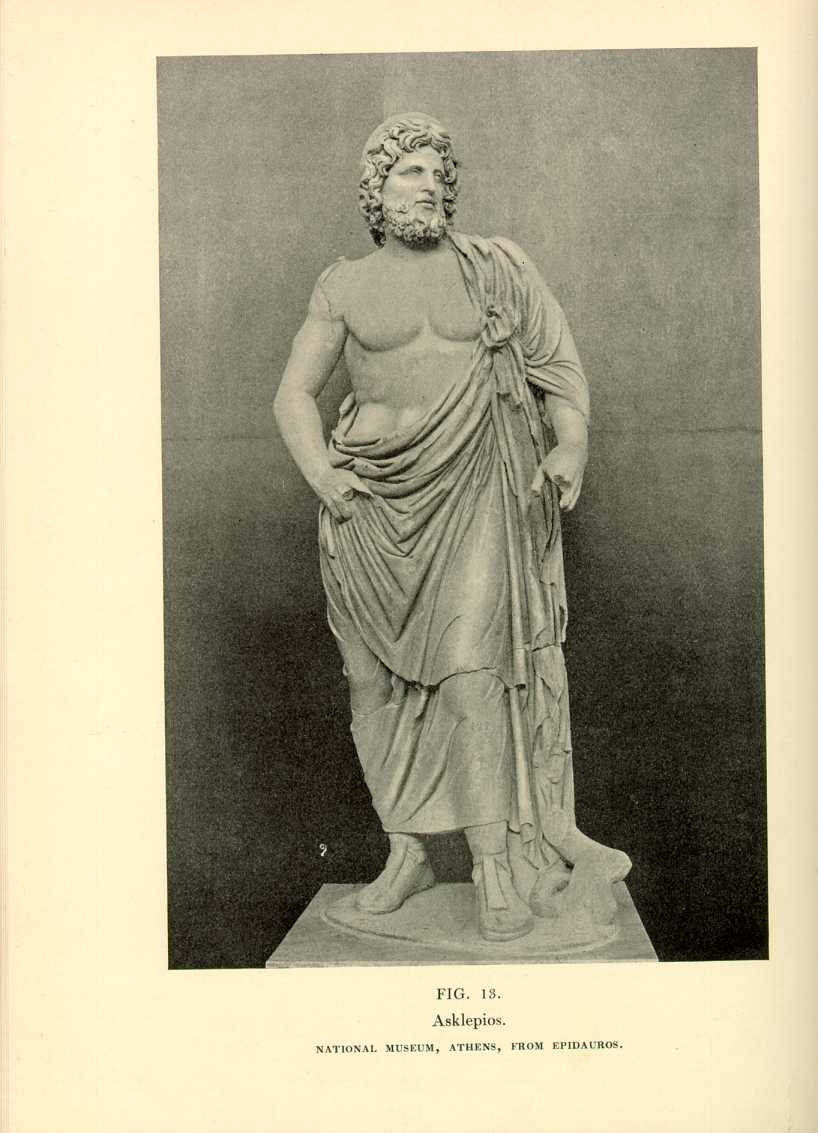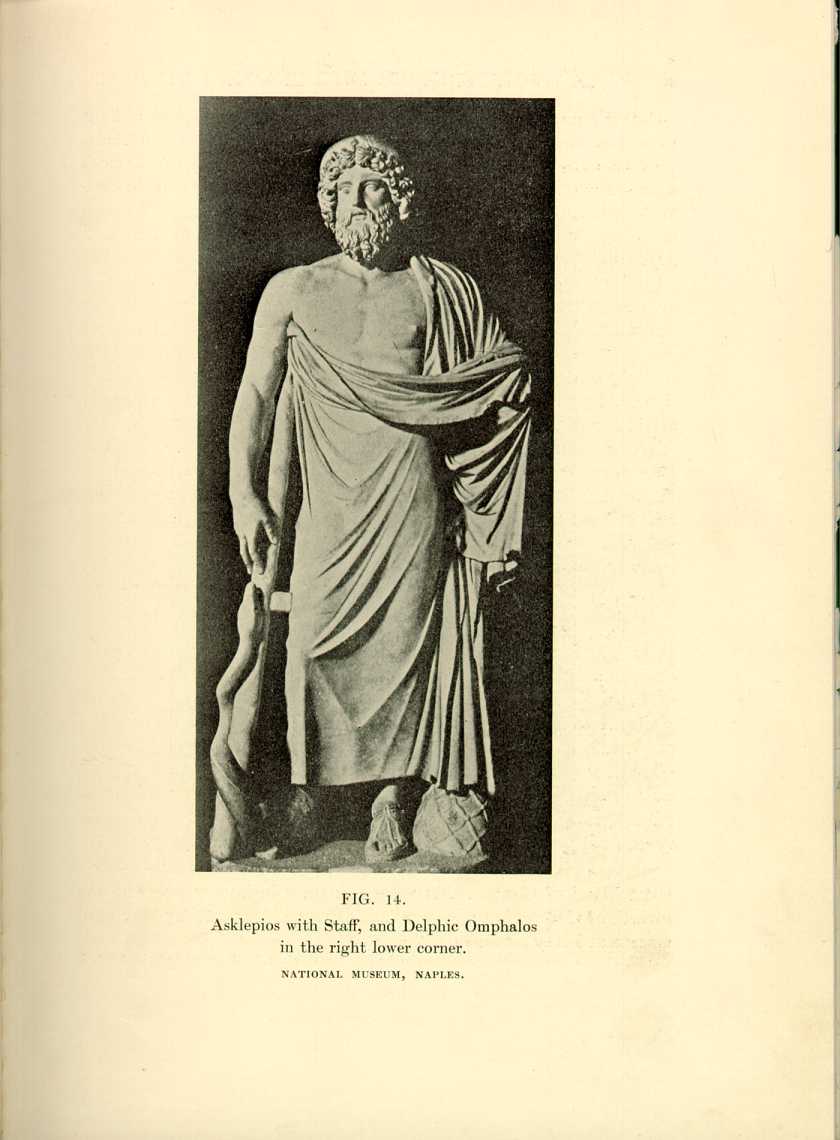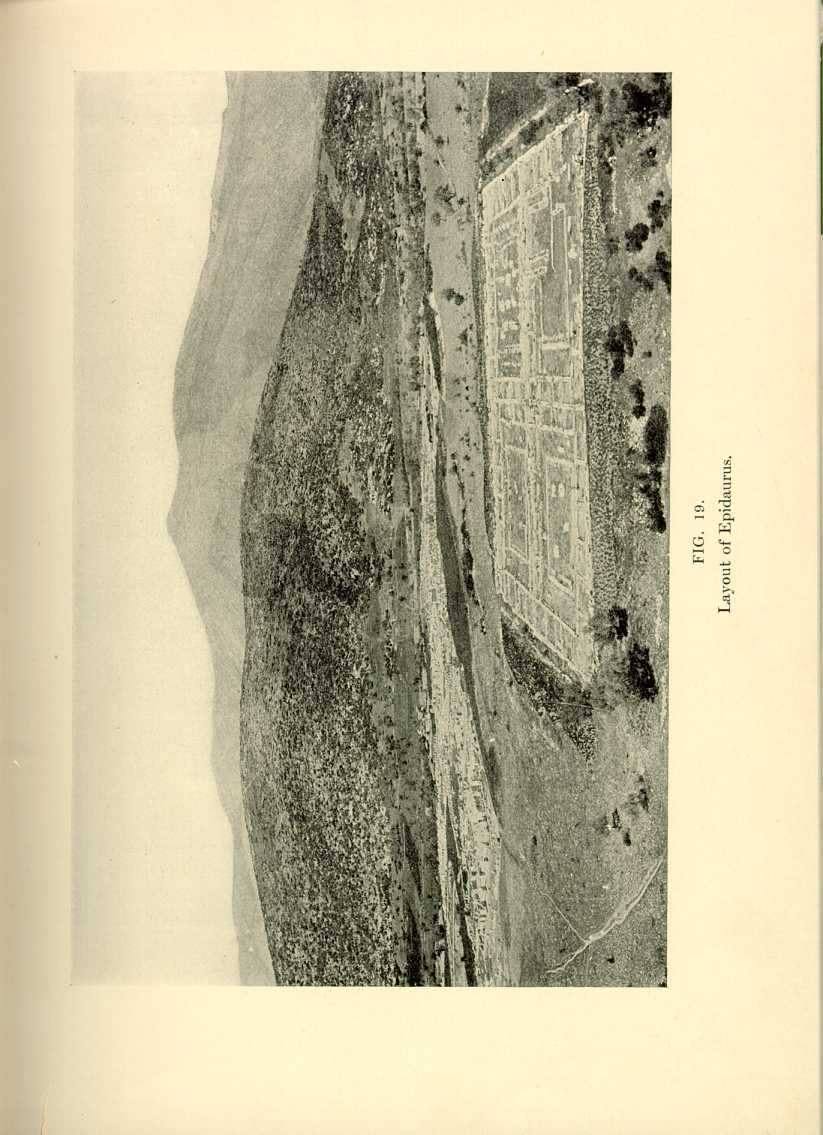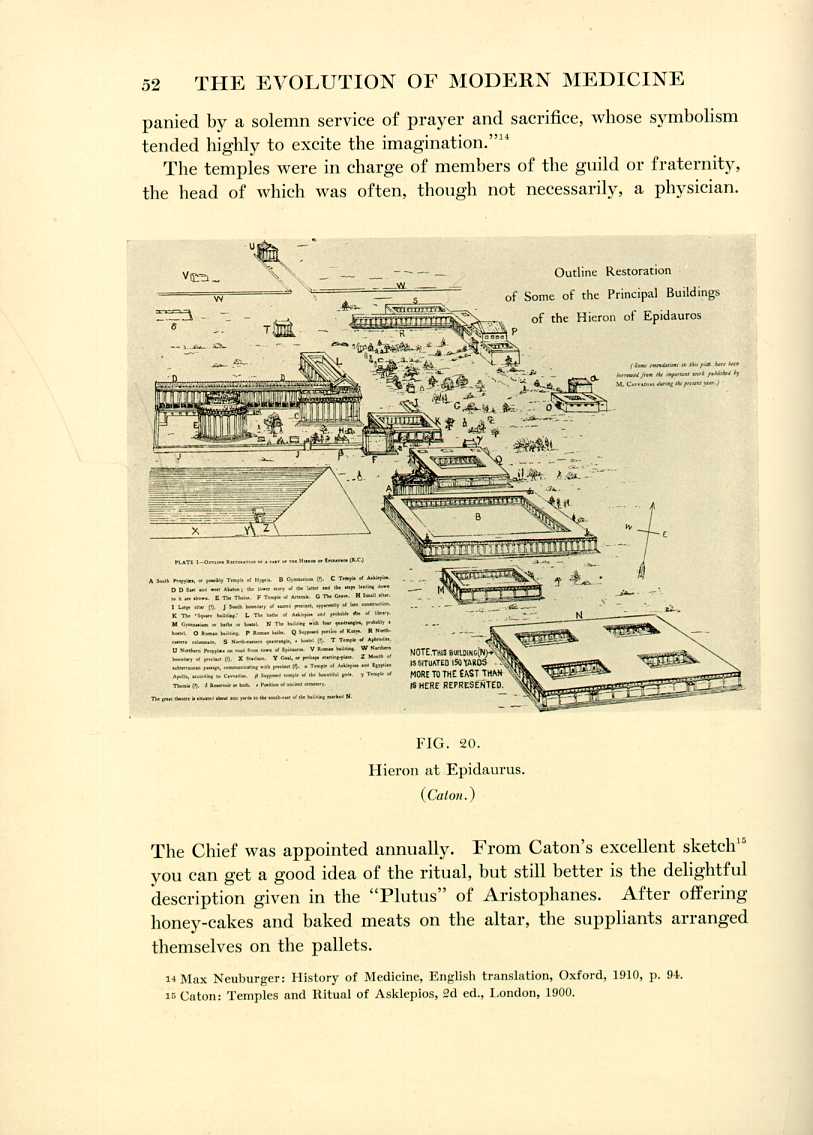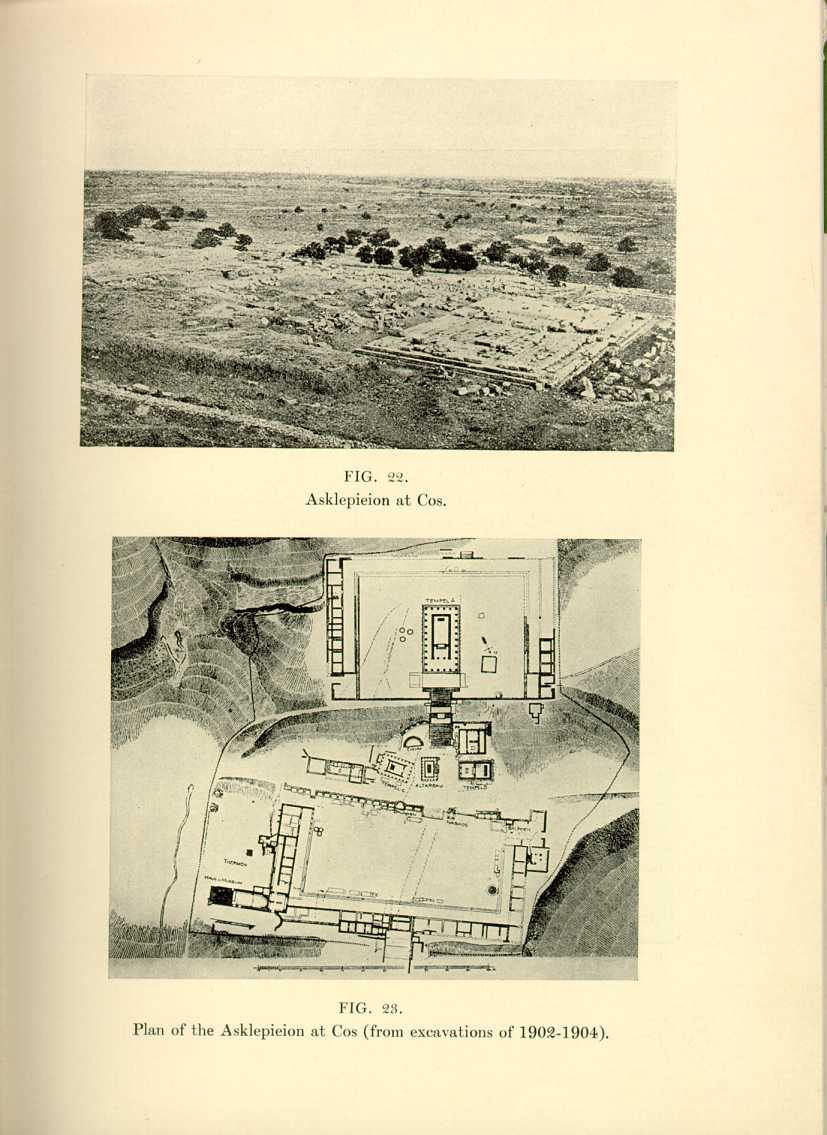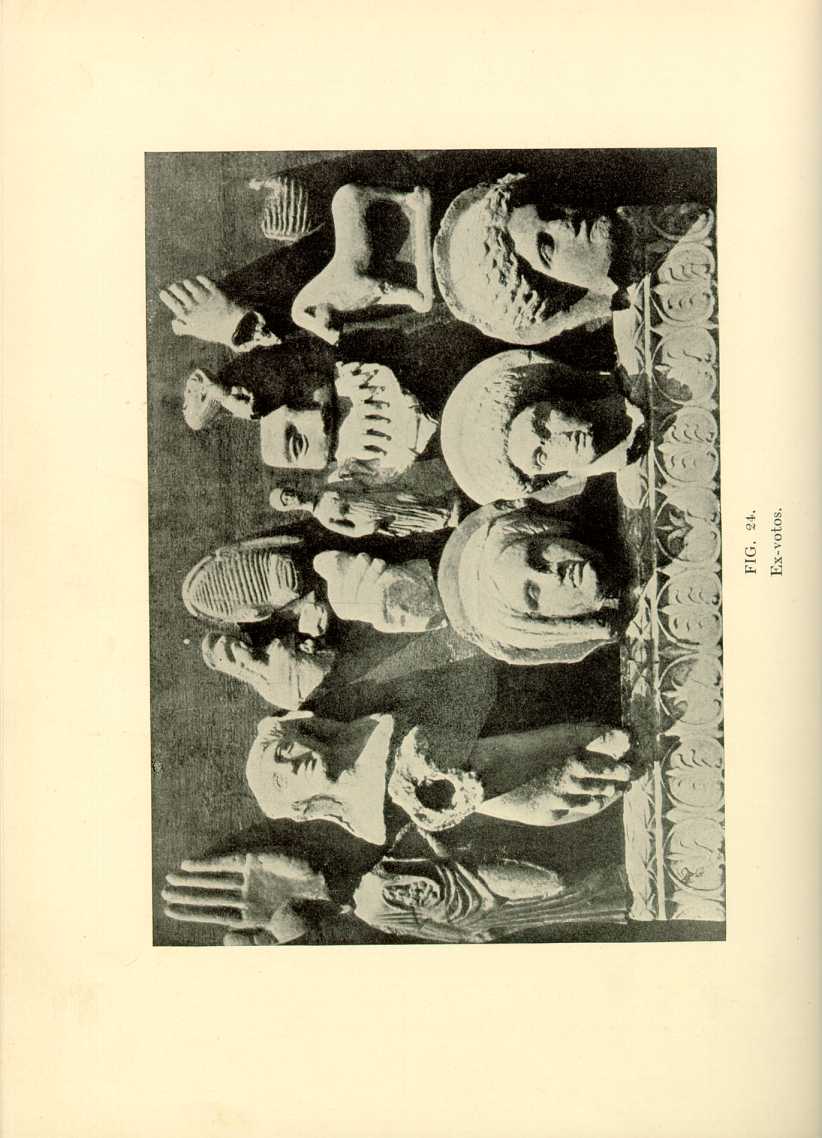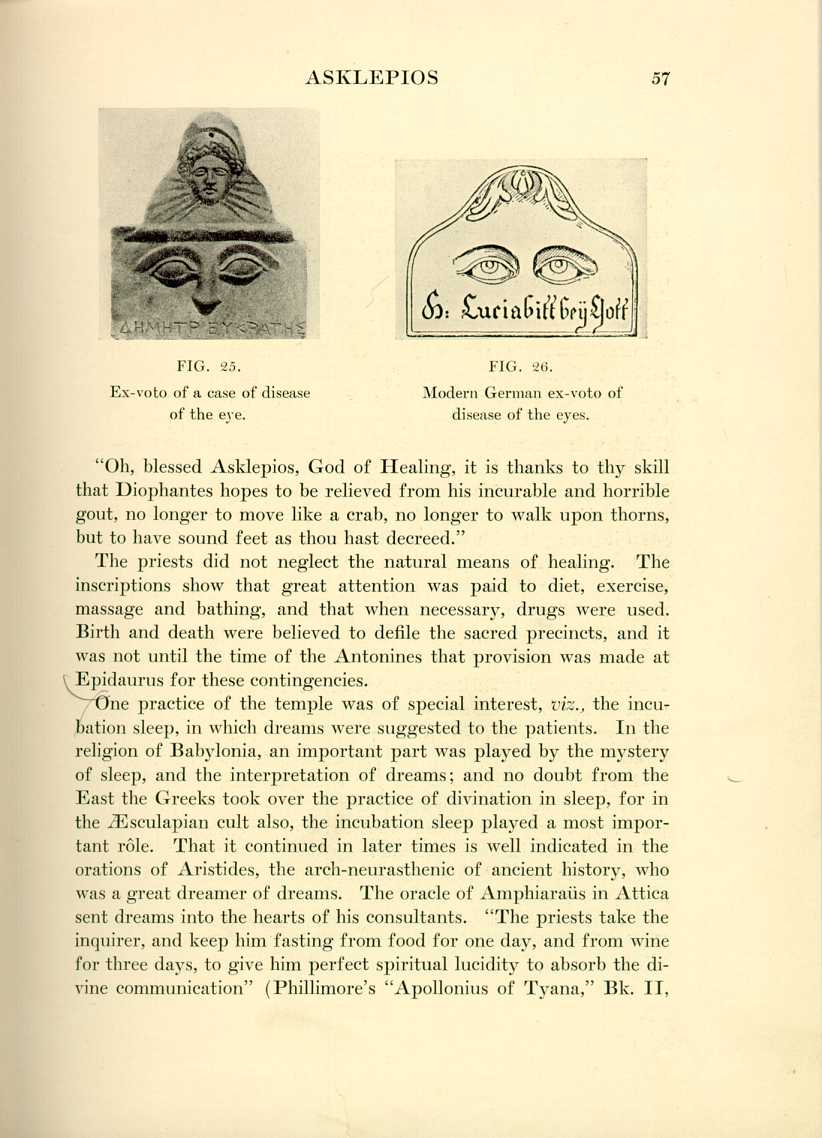| CHAPTER II The Evolution of Modern Medicine | ||
ASKLEPIOS
No god made with hands, to use the scriptural phrase, had a more successful "run" than Asklepios—for more than a thousand years the consoler and healer of the sons of men. Shorn of his divine attributes he remains our patron saint, our emblematic God of Healing, whose figure with the serpents appears in our seals and charters. He was originally a Thessalian chieftain, whose sons, Machaon and Podalirius, became famous physicians and fought in the Trojan War. Nestor, you may remember, carried off the former, declaring, in the oft-quoted phrase, that a doctor was better worth saving than many warriors unskilled in the treatment of wounds.
Later genealogies trace his origin to Apollo, [41] as whose son he is usually regarded. "In the wake of northern tribes this god Aesculapius— a more majestic figure than the blameless leech of Homer's song—came by land to Epidaurus and was carried by sea to the east-ward
island of Cos.... Aesculapius grew in importance with the growth of Greece, but may not have attained his greatest power until Greece and Rome were one."[42]
A word on the idea of the serpent as an emblem of the healing art which goes far back into antiquity. The mystical character of the snake, and the natural dread and awe inspired by it, early made it a symbol of supernatural power. There is a libation vase of Gudea, c. 2350 B. C., found at Telloh, now in the Louvre (probably the earliest representation of the symbol), with two serpents entwined
round a staff (Jastrow, Pl. 4). From the earliest times the snake has been associated with mystic and magic power, and even today, among native races, it plays a part in the initiation of medicine men.
In Greece, the serpent became a symbol of Apollo, and prophetic serpents were kept and fed at his shrine, as well as at that of his son, Asklepios. There was an idea, too, that snakes had a knowledge of herbs, which is referred to in the famous poem of Nikander on Theriaka.[43] You may remember that when Alexander, the famous quack and oracle monger, depicted by Lucian, started out "for revenue," the first thing he did was to provide himself with two of the large, harmless, yellow snakes of Asia Minor.
The exact date of the introduction of the cult into Greece is not known, but its great centres were at Epidaurus, Cos, Pergamos and Tricca. It throve with wonderful rapidity. Asklepios became one of the most popular of the gods. By the time of Alexander it is estimated that there were between three and four hundred temples dedicated to him.
His worship was introduced into Rome at the time of the Great Plague at the beginning of the third century B. C. (as told by Livy in Book XI), and the temple on the island of Tiber became a famous resort. If you can transfer in imagination the Hot Springs of Virginia to the neighborhood of Washington, and put there a group of buildings such as are represented in these outlines of Caton's [44] (p. 52), add a sumptuous theatre with seating capacity for 20,000, a stadium 600 feet long with a seating capacity of 12,000, and all possible accessories of art and science, you will have an idea of what the temple at Epidaurus, a few miles from Athens, was. "The cult flourished mostly in places which, through climatic or hygienic advantages, were natural health resorts. Those favoured spots on hill or mountain, in the shelter of forests, by rivers or springs of pure flowing water, were conducive to health. The vivifying air, the well cultivated gardens surrounding the shrine, the magnificent view, all tended to cheer the heart with new hope of cure. Many of these temples owed their fame to mineral or merely hot springs. To the homely altars, erected originally by sacred fountains in the neighbourhood of health-giving
mineral springs, were later added magnificent temples, pleasure-grounds for festivals, gymnasia in which bodily ailments were treated by physical exercises, baths and inunctions, also, as is proved by excavations, living rooms for the patients. Access to the shrine was forbidden to the unclean and the impure, pregnant women and the mortally afflicted were kept away; no dead body could find a resting-place within the holy precincts, the shelter and the cure of the sick being undertaken by the keepers of inns and boarding-houses in the neighbourhood. The suppliants for aid had to submit to careful purification, to bathe in sea, river or spring, to fast for a prescribed time, to abjure wine and certain articles of diet, and they were only permitted to enter the temple when they were adequately prepared by cleansing, inunction and fumigation. This lengthy and exhausting preparation, partly dietetic, partly suggestive, was accompanied
by a solemn service of prayer and sacrifice, whose symbolism tended highly to excite the imagination."[45]
The temples were in charge of members of the guild or fraternity, the head of which was often, though not necessarily, a physician.
The Chief was appointed annually. From Caton's excellent sketch [46] you can get a good idea of the ritual, but still better is the delightful description given in the "Plutus" of Aristophanes. After offering honey-cakes and baked meats on the altar, the suppliants arranged themselves on the pallets.
Put out the lights and bade us fall asleep,
Nor stir, nor speak, whatever noise we heard.
So down we lay in orderly repose.
And I could catch no slumber, not one wink,
Struck by a nice tureen of broth which stood
A little distance from an old wife's head,
Whereto I marvellously longed to creep.
Then, glancing upwards, I beheld the priest
Whipping the cheese-cakes and figs from off
The holy table; thence he coasted round
To every altar spying what was left.
And everything he found he consecrated
Into a sort of sack—[47]
a procedure which reminds one of the story of "Bel and the Dragon." Then the god came, in the person of the priest, and scanned each patient. He did not neglect physical measures, as he brayed in a mortar cloves, Tenian garlic, verjuice, squills and Sphettian vinegar, with which he made application to the eyes of the patient.
And out there issued from the holy shrine
Two great, enormous serpents....
And underneath the scarlet cloth they crept,
And licked his eyelids, as it seemed to me;
And, mistress dear, before you could have drunk
Of wine ten goblets, Wealth arose and saw. [48]
The incubation sleep, in which indications of cure were divinely sent, formed an important part of the ritual.
The Asklepieion, or Health Temple of Cos, recently excavated, is of special interest, as being at the birthplace of Hippocrates, who was himself an Asklepiad. It is known that Cos was a great medical school. The investigations of Professor Rudolf Hertzog have shown that this temple was very nearly the counterpart of the temple at Epidaurus.
The Æsculapian temples may have furnished a rare field for empirical
the Christian era, there is evidence of the association of distinguished physicians with Æsculapian temples. I notice that in one of his ana-tomical treatises, Galen speaks with affection of a citizen of Pergamos who has been a great benefactor of the Æsculapian temple of that city. In "Marius, the Epicurean," Pater gives a delightful sketch of one of those temple health resorts, and brings in Galen, stating that he had himself undergone the temple sleep; but to this I can find no reference in the general index of Galen's works.
From the votive tablets found at Epidaurus, we get a very good idea of the nature of the cases and of the cures. A large number of them have now been deciphered. There are evidences of various forms of diseases of the joints, affections of women, wounds, baldness, gout; but we are again in the world of miracles, as you may judge from the following: "Heraicus of Mytilene is bald and entreats the God to make his hair grow. An ointment is applied over night and the next morning he has a thick crop of hair."
There are indications that operations were performed and abscesses opened. From one we gather that dropsy was treated in a novel way: Asklepios cuts off the patient's head, holds him up by the heels, lets the water run out, claps on the patient's head again. Here is one of the invocations:
"Oh, blessed Asklepios, God of Healing, it is thanks to thy skill that Diophantes hopes to be relieved from his incurable and horrible gout, no longer to move like a crab, no longer to walk upon thorns, but to have sound feet as thou hast decreed."
The priests did not neglect the natural means of healing. The inscriptions show that great attention was paid to diet, exercise, massage and bathing, and that when necessary, drugs were used. Birth and death were believed to defile the sacred precincts, and it was not until the time of the Antonines that provision was made at Epidaurus for these contingencies.
One practice of the temple was of special interest, viz., the incubation sleep, in which dreams were suggested to the patients. In the religion of Babylonia, an important part was played by the mystery of sleep, and the interpretation of dreams; and no doubt from the East the Greeks took over the practice of divination in sleep, for in the Æsculapian cult also, the incubation sleep played a most important rôle. That it continued in later times is well indicated in the orations of Aristides, the arch-neurasthenic of ancient history, who was a great dreamer of dreams. The oracle of Amphiaraüs in Attica sent dreams into the hearts of his consultants. "The priests take the inquirer, and keep him fasting from food for one day, and from wine for three days, to give him perfect spiritual lucidity to absorb the divine communication" (Phillimore's "Apollonius of Tyana," Bk. II,
In its struggle with Christianity, Paganism made its last stand in the temples of Asklepios. The miraculous healing of the saints superseded the cures of the heathen god, and it was wise to adopt the useful practice of his temple.
Aristophanes: B. B. Roger's translation, London, Bell & Sons, 1907, Vol. VI, ll. 668, etc., 732 ff.
| CHAPTER II The Evolution of Modern Medicine | ||
